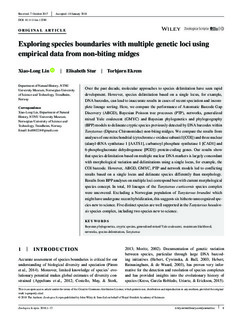| dc.description.abstract | Over the past decade, molecular approaches to species delimitation have seen rapid development. However, species delimitation based on a single locus, for example, DNA barcodes, can lead to inaccurate results in cases of recent speciation and incomplete lineage sorting. Here, we compare the performance of Automatic Barcode Gap Discovery (ABGD), Bayesian Poisson tree processes (PTP), networks, generalized mixed Yule coalescent (GMYC) and Bayesian phylogenetics and phylogeography (BPP) models to delineate cryptic species previously detected by DNA barcodes within Tanytarsus (Diptera: Chironomidae) non-biting midges. We compare the results from analyses of one mitochondrial (cytochrome c oxidase subunit I [COI]) and three nuclear (alanyl-tRNA synthetase 1 [AATS1], carbamoyl phosphate synthetase 1 [CAD1] and 6-phosphogluconate dehydrogenase [PGD]) protein-coding genes. Our results show that species delimitation based on multiple nuclear DNA markers is largely concordant with morphological variation and delimitations using a single locus, for example, the COI barcode. However, ABGD, GMYC, PTP and network models led to conflicting results based on a single locus and delineate species differently than morphology. Results from BPP analyses on multiple loci correspond best with current morphological species concept. In total, 10 lineages of the Tanytarsus curticornis species complex were uncovered. Excluding a Norwegian population of Tanytarsus brundini which might have undergone recent hybridization, this suggests six hitherto unrecognized species new to science. Five distinct species are well supported in the Tanytarsus heusdensis species complex, including two species new to science. | nb_NO |

